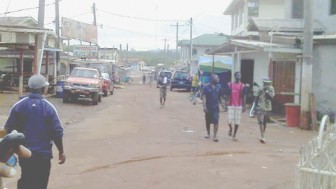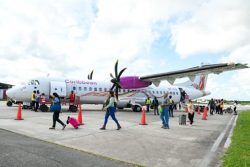Mahdia is full of surprises. Not least of those is the fact that if you travel to this small township in the Potaro-Siparuni region you are more likely than not to meet one, possibly more, fellow coastlanders. All of them have decided that, for the time being at least, Mahdia is the place to be.
It is, in every case, an economic decision. Time was when some of the earlier inhabitants of Mahdia including Africans, the indigenous Patamonas and later on, immigrants from some of the smaller Caribbean islands, subsisted in an economy that comprised mainly farming, hunting, small-scale mining and coal burning; all that has changed. Unofficial estimates indicate that there could be as many as 150 dredges ‘working gold’ at Mahdia. The rest of the township’s economy revolves around the gold industry.
Trevor is in the business of ferrying supplies from Georgetown to Mahdia. Eighty per cent of his business transactions are done with dredge owners. If you can move stock to Mahdia you will sell that stock. It’s easier if you have your own transportation. Moving goods from Georgetown to Mahdia could cost you amounts ranging from $8,000 for small parcels to $100,000 for a major consignment.

When Stabroek Business visited last week, persons said prices were going up. Eggs were $50 each; bananas, $300 per pound and cassava and eddo, $200 per pound.
A garrulous woman, who declined to give her name, was fretting over the fact that over the past few weeks business was “falling off”. She, too, moves goods to Mahdia and the miners are her primary market. She attributes the “falling off” in large measure to the inclement weather, though she believes that the bigger problem has to do with the increasing number of shops that are being set up closer to the backdam.
There are taxis everywhere, mostly driver-owned. Two drivers who had worked in areas of coastal Guyana, said that Mahdia “is good business”. The community would appear to have quite a few affluent residents. They travel to work in taxis and their children are ferried to school in taxis. A ride around the Mahdia could cost $1,000; you need to see the roads to understand why. They are in a deplorable state
One of the two drivers with whom this newspaper spoke was keen to make the point that his takings are around $30,000 per day. He goes to the backdam often. The trip could cost up to $10,000. It’s a tough trip. The car has to be prepared for the ride; the right tyres and the re-enforcement of the shocks and suspension.

It is not only the taxi drivers that complain about the roads. The business community complains as well. When the dust is swirling at the fiercest they retreat to the backs of their business places, re-emerging only when customers show up. One businessman told Stabroek Business that he understands that government has just voted money for the roads and the repairs and rehabilitation will begin shortly.
After the Great Fire of July 2010 that gutted most of the commercial area there is evidence of rebuilding. People have benefited from state assistance and the victims are in various stages of recovery. A Fire Service is one of Mahdia’s obvious needs. The tragedy of two years ago was entirely avoidable.
Every community in Guyana has one or more people whose names ring bells. In Mahdia the name Roger Hinds rings bells. His ‘Blue Ribbon’ asset is a 32- room hotel that more or less makes other buildings look quite ordinary. Hinds is the best example of a businessman who has done well at Mahdia.
There are other guest houses at Mahdia too; and there are supermarkets and restaurants and night clubs and beauty salons. Where there is gold there is entertainment and what some residents of Mahdia describe as “good living.”
The community has a 24-hour electricity supply provided by the Mahdia Power and Light. Rain and the Salbora Falls take care of water. Recently, there have been problems with the routine supply. Last week people were transporting water from one creek or another with their cars and cruisers.
Mahdia, it seems, is transforming lives. This publication met two men from West Coast Demerara who were rejoicing in the fact that they had found work in the goldfields at Mahdia and could send money home to their relatives. Women are embracing the opportunities afforded by Mahdia too.
In some respects, Mahdia bears a striking resemblance to a frontier township; an oasis of civilization in rough, open country where the presence of gold holds out promises of transformation over a period of time. It may be that it is a microcosm of something bigger, more promising, perhaps a development that will kick start a population shift away from coastal Guyana to what it seems are the more promising regions of the Republic.





